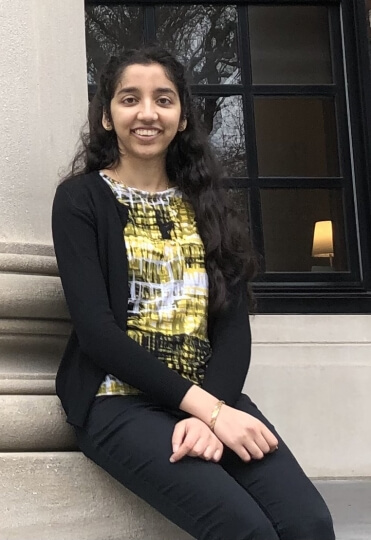Mythri Ambatipudi, S.B. ‘22, designed a machine learning algorithm to assist with combination antibiotic therapies for her senior capstone project. (Credit: Mythri Ambatipudi)
Engineering Design Projects (ES 100), the capstone course at the Harvard John A. Paulson School of Engineering and Applied Sciences (SEAS), challenges seniors to engineer a creative solution to a real-world problem.
Combination Antibiotic-Focused Machine Learning Models for Integration into Experimental Workflows
Mythri Ambatipudi, S.B. ‘22, biomedical engineering
What did you do for your project?
With antibiotic resistance impeding the efficacy of existing antibiotics and the discovery of new antibiotics slowing, combination therapies provide ways of extending the lifespan of existing antibiotics and treating resistant infections. In this project, I developed machine learning models to predict the synergistic activity of antibiotic-adjuvant pairwise combinations against E. coli. The aim of this project was to engineer an accurate, computationally efficient, and user-friendly implementation of a machine learning algorithm that can integrate into experimental workflows to accelerate the discovery, screening, and validation of combination antibiotic therapies.
How did you come up with this idea for your final project?
When I first started working in the laboratory of James J. Collins, I was working on machine learning models for predicting the efficacy of therapies using a single antibiotic agent. During that project, I learned about combination antibiotic therapies and their unique approach towards combating antibiotic resistance. However, I also learned about the immense amounts of time and experimental effort required to test and validate combinations of antibiotics and adjuvants, which are substances that increase or modulate the immune response. Creating machine learning models that could help accelerate the discovery and testing of combinations seemed like a really great way to tackle this problem. Especially since predictions regarding combinations of molecules is a much more difficult computational and chemical problem, this topic was one that seemed really interesting and piqued my curiosity.
What real-world challenge does this project address?
Antibiotic resistance is a really urgent public health issue that’s only growing in magnitude. And at the same time, the rate of discovery of antibiotics has slowed down quite a lot in the last few decades. That means that the pool of effective antibiotics that are available to treat bacterial infections is steadily shrinking. So it’s extremely important to create ways of more rapidly testing and discovering therapies that can remain effective against resistant bacteria longer.
How did your project come together over the course of the year?
The first few weeks of the project were spent creating technical specifications and general guidelines to structure my project and its intended outcomes and goals. During the bulk of my project, I designed and built three machine learning models along with a user interface. Each model took anywhere from 1-3 months to design, build and test.
What part of the project proved the most challenging?
The process of training and testing these models is very computationally taxing. There were a lot of model design details to think through, as well as a lot of challenging memory allocation-related issues that had to be resolved.
What part of the project did you enjoy the most?
Although it was challenging, I really did enjoy working through the process of designing and coding each of the three models I was testing. It was very interesting to see the nuances in the inputs for each model type, the design features that were more or less impactful in different models, and the overall performance metrics.
What skills did you gain through your project?
In addition to learning an incredible amount about the engineering design process, I also learned quite a bit about machine learning and the intricacies and nuances that differentiate different ML model types. My coding skills have definitely improved as a result of this project, in addition to my ability to work through convoluted computational problems. The process of designing and presenting the user interface also taught me a lot about presenting a highly technical computational problem in a more easily accessible way. Overall, this whole project taught me a lot about working through the entire problem solving chain, from defining the problem and the goals to designing, building, and testing a final product.
Press Contact
Matt Goisman | mgoisman@g.harvard.edu
